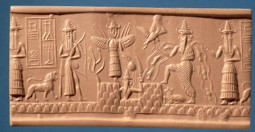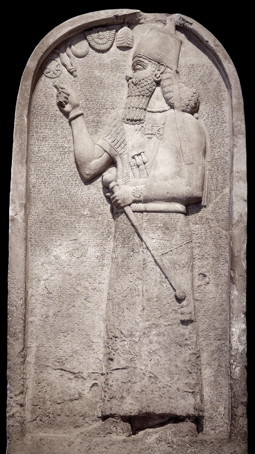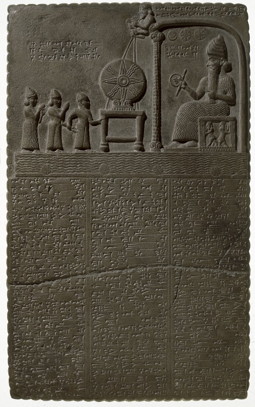Utu/Šamaš (god)
Mesopotamian sun god, who was associated with life, justice, divination and the netherworld.
Functions

Cylinder seal TT of a scribe named Adda, showing Šamaš cutting through mountains on the horizon so he can rise in the morning; ca. 2300-2200 BCE (BM 89115). © The British Museum. View large image on the British Museum's website.

Stone stele of Assyrian king Ashurnasirpal II from Nimrud (ancient Kalhu), northern Iraq, approx. 883-859 BC (BM 118805). This monument shows the king worshipping the major gods in symbolic form, including Šamaš, whose symbol is the winged disc. © The British Museum. View large image on the British Museum's website.

Limestone tablet depicting king Nabu-aplu-iddina being led into the presence of Šamaš, the sun god; 860 BCE-850 BCE. Šamaš sits in the E-babbar shrine and holds the rod and ring symbols of powerful kingship (BM 91000). © The British Museum. View large image on the British Museum's website.
Šamaš the all-seeing
Šamaš (Sumerian Utu) is the god of the sun. He brings light and warmth to the land, allowing plants and crops to grow. At sunrise Šamaš was known to emerge from his underground sleeping chamber and take a daily path across the skies [Image 1]. As the sun fills the entire sky with light, Šamaš oversaw everything that occurred during the daytime. He thus became the god of truth, judgements and justice. Šamaš also played a role in treaties, oaths and business transactions, as he could see through deceit and duplicity. As a defender of justice, the sun god also had a warrior aspect (Black and Green 1998: 183-4).
Let there be truth!
Šamaš also played an essential role in sacrificial divination (extispicy) rituals (Robson 2010b). Extispicy was an important branch of royal court scholarship in existence for over a millennium, whereby the king could receive answers from the gods to specific questions regarding matters of state. The king's diviners (bārû) asked the gods to write the answer in the liver of a sheep, which was then 'read' through examining the liver and counting up its ominous features. As god of truth and justice, Šamaš was implored to help provide a correct answer. A late second-millennium prayer to Šamaš by a diviner asks him to guide the inquiry and to 'let there be truth' in their interpretations of the omens. (Foster 2005: 756).
Assisting humanity and the underworld
Šamaš also played a role in the affairs of humanity. Surviving second millennium texts indicate that his assistance was sought against evil and curses. Literary texts describe his protection of the heroic kings of the city of Uruk. In the Epic of Gilgameš he assists the hero Gilgameš in defeating the monstrous Humbaba, the guardian of the Cedar Forest. Šamaš was also specifically a protector of travellers and merchants (Foster 2005: 627, 630, 633).
Šamaš played a similarly important role in the realm of the dead as he did in the living world. The spirits of the dead were thought to enter the netherworld via a passage on the horizon in the extreme western part of the world. In some traditions, this passage was the same entrance that led to Šamaš's underground dwelling, and to which he returned at sunset each evening (Bottero 2002: 274). However, Tablet XI of Gilgameš from Nineveh describes Šamaš's road underneath the earth as a separate path from that to the netherworld (Bottero 2002: 274-5).
Divine genealogy and syncretisms
In Sumerian tradition, Utu is the son of the moon god Nanna-Suen and the twin brother of Inana. Akkadian tradition sometimes made Šamaš the son of Anu or Enlil. The sun god's wife was Aya, goddess of the dawn (Black and Green 1998: 183-4).
Šamaš had a minister named Bunene who drove his fiery chariot and was known as Šamaš's son in some traditions. Bunene was worshipped in his own right in Sippar and Uruk during the Old Babylonian period (Black and Green 1998: 183-4).
Cult place(s)
Šamaš's cult centres were the cities of Sippar and Larsa, which both had a temple to the sun god called E-babbar ('White House').
Time periods attested
Šamaš is attested from the earliest periods right through the timespan of cuneiform culture. He appears in a wide range of text genres including royal prayers and hymns, divination texts, treaties and documents recording business transactions. A more detailed overview will have to await further studies.
The first literary text in the Akkadian language was a hymn to Šamaš that was found among the texts from Tell Abu Salabikh (ca. 2600 BCE). Although poorly understood, it seems to contain narrative passages as well as a hymnic introduction and end (Krebernik 1998: 320).
The second-millennium Sumerian Hymn to Utu (ETCSL 4.32.2) describes the sun god's shining appearance and powers of judgment by saying that his 'radiance spreads out like a net over the world'. A Sumerian literary letter-prayer from king Sîn-iddinam of Larsa addresses Utu as the patron deity of the city of Larsa and prays for redemption of the city and its king (ETCSL 3.2.05; Brisch 2007: 158-78). Another hymn to Šamaš praises the sun god's all-seeing nature as 'illuminator of all', which allows him to see the truth in trials and verdicts. First-millennium copies of this hymn also survive, indicating that it was studied by successive generations of scholars (Foster 2005: 627-35). A second-millennium prayer to be recited at sunset gives a homely description of Šamaš returning to his dwelling at the end of the day. Firstly, the sun god is saluted by his gatekeeper, who opens the door to his chambers, then he settles down to dinner cooked by his wife Aya (Foster 2005: 752-3).
Šamaš was highly significant in the Neo-Assyrian royal court due to his associations with sacrificial divination TT . Approximately 350 surviving queries and reports (SAA 4 [http://oracc.museum.upenn.edu/saao/saa04/]) give details of the questions posed to Šamaš by the kings Esarhaddon and Assurbanipal, which include worries about rebellions, illnesses and the loyalty of subordinates (Starr 1990: xiv).
Royal hymns praise Šamaš and also commemorate rebuilding of his temples by particular kings, including as Assyrian king Assurbanipal (668-631 BCE) and Babylonian king Nabopolassar (625-605 BCE) (Foster 2005: 827-8, 848).
Iconography
Šamaš's symbol from the Akkadian period to the Neo-Babylonian period was the solar disc. It usually took the form of a four-pointed star, with curved lines emerging between each point (Black and Green 1998: 168). On Neo-Assyrian stelae and kudurrus TT Šamaš was represented by a winged solar disc [Image 2].
Depictions of Šamaš himself survive on cylinder seals TT , where he is sometimes shown seated and surrounded by worshippers, with his sunrays emanating from his shoulders (Black and Green 1998: 183). The sun god is also portrayed on the famous stele TT of King Hammurabi from 1760 BCE, which is inscribed with over 282 'laws' for the unified territories of Babylonia. In the image Šamaš, as god of justice, presents Hammurabi with tools for ruling justly: he passes the king a measuring rod and rope . Justice in early Mesopotamian was closely allied with the idea that fairness could be achieved through literacy, numeracy and accurate measurement. The measuring instruments are a symbol of powerful kingship, representing the ability to rule justly and fairly (see Robson 2008: 115-24; 263-7). Very similar imagery of the sun god also appears on a first-millennium tablet commemorating the revival of the Ebabbar cult by king Nabu-apla-iddina (887-855 BCE) (Woods 2004) [Image 3].
Name and Spellings
Utu's name is spelled dutu in Sumerian, and Šamaš's name retains this logogram in Akkadian. The name Šamaš is a variant form of the Akkadian word for sun, šamšu (compare Arabic šams, Hebrew šemeš).
- First-millennium written forms include:
- 20; d20; dUTU-KAM; dUTU-ši; dUTU-šu2; dša2-maš; dša3-maš2; dša2-maš; šu-ša2-na-ku.
- Normalised forms include:
- Šamaš, Šamši, Šamšu
Utu in Online Corpora
- The Electronic Text Corpus of Sumerian Literature
- The Cuneiform Digital Library Initiative [http://www.cdli.ucla.edu/cdlisearch/search/index.php?SearchMode=Line&txtContent={d}utu&requestFrm=Search]
- The Electronic Text Corpus of Sumerian Royal Inscriptions [http://oracc.museum.upenn.edu/etcsri/qpn-x-divine?utu]
Šamaš in online corpora
References and further reading
- Starr 1990, Queries to the Sungod.
- Woods 2004, "The sun-god tablet."
Ruth Horry
Ruth Horry, 'Utu/Šamaš (god)', Ancient Mesopotamian Gods and Goddesses, Oracc and the UK Higher Education Academy, 2019 [http://oracc.museum.upenn.edu/amgg/listofdeities/utu/]